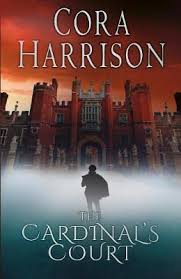GoodReads meta-data is 320 pages rated 4.00 by 44 litizens.
Genre: krimi, period

Verdict: [Not sure.]
Henry VIII together with his queen, Katharine, is in residence at Cardinal Thomas Wolsey’s folly, Hampton Court built in 1515 it has all modern conveniences, namely hot and cold running servants. Flemish tapestries to reduce draughts, decorated fire buckets at every fire place, and more. Wolsey is chief minister to the mercurial King, having built the palace to serve as a royal residence, as a diplomatic embassy, and as his own residence. Thus forty rooms are reserved for the royal party, and another forty set aside for visiting diplomats, and so on. Kitchens, stables, latrines are sufficient to service a thousand guests. Imagine that. Well maybe that is TMI.
The building is baroque and so are the people. The intrigues are many. There are rivals for the king’s favour. There are conflicts over inheritances among the courtiers. There are sexual liaisons, financial corruption, and the like. Queen Kathrine has produced no male heir, and that is a storm brewing that readers realise more than the characters with our hindsight.
It is the very cold Lent of 1522 when into this happy throng comes Hugh Mac Egan from Ireland, a lawyer sent to prepare a marriage contract for the son of his client, the Earl of Ormond. The boy, James, is a page to the Cardinal, along with eleven other youths, heirs to mighty lords of the land. James’s intended is Anne Boleyn.
She dominates much of the early going. Indeed, too much for this reader. She is described at least four times before my trigger finger got itchy and I started flicking pages whenever she appeared. Her lustrous eyes, her swaying carriage, her husky voice, her almond face, her clear skin, her gleaming hair, her ……. Enough. She is way out of James’s league but no one seems to notice that, apart from the lady herself, who has another in mind, another page at this stage, young Harry Percy who is the scion of the Earl of Northumberland, who is Midas rich. She spends a lot of time rubbing Harry up the right way.
Then, it seems during a Lentan meal with the king present, a courtier is murdered, and the circumstantial evidence points to James. Hugh undertakes his defence, in between recitations of Boleyn’s features. While much is made of the fact that the crime occurred in the king’s presence the investigation is lethargic to say the least. There is a jurisdictional dispute between the king’s sheriff and the cardinal’s over whose case it is. That has potential but since both of this officers are portrayed as dimwits, it is not developed.
Much is made of the difference between Irish and English law, but that does not effect the plot. It is simply a didactic aside.
Queen Katharine is shown to be much more than the religious zealot to which she is usually reduced in the popular culture. She is well aware of the currents eddying and swirling around the court, and offers Hugh some insightful and intelligent assistance so subtlety that he almost misses it while enumerating Boleyn’s attributes. The queen is an old hand at seeming to do nothing while doing something in a court where her every gesture is noted, codified, catalogued, recorded, reported, and analysed.
Likewise, as all powerful as Wolsey appears from afar, he is well aware that everything depends on Henry’s indulgence, and judging the limits of that indulgence is tricky from day to day with such a changeable man. Best therefore to do little by halves, always checking the wind.
One of the pillars of the krimi is the rush to judgement. A crime occurs. Officials latch onto a suspect and declare guilt. Case closed. Our hero then struggles to re-open the case and to defend the suspect. There is never much of an explanation, if any, about why the officials are satisfied to let the real culprit escape while they convict an innocent. It cannot be just incompetence else they are not worthy of the steel of our hero, so they have reasons, which usually amount to a bribe. Yet in accepting a bribe to permit a murder, they expose themselves to a like risk and more. It seldom adds up. Life can be like that but not literature.
Sometimes period krimis have too much period exposition and not enough krimi (mystery, investigation, surmise). Authors having done extensive research want to make use of all they learned and the exercise becomes didactic not entertainment. This one uses much period nomenclature, some of it Gaelic, and I was glad to have the Kindle dictionary to the ready. There is also much description of the kitchens, the corridors, and rooms, little of which relates to the crime. For the purposes of the plot we did not need to know that there were four or five kitchens, each with its own store rooms, etc., but told we are.
A few niggles about the plot remain, though I admit my speed page flicking may be the explanation. I never did figure out why Ann ‘Much-Described’ Boleyn risked so much on the spur of the moment and evidently convinced her paramour instantly to do the same almost. Nor was I sure what the point was of the torture and murder of the servant, while locking our hero in a box. Did the murderer of the doctor ever face punishment. Hard to tell.
A final plaint. Lawyer Mac Egan repeatedly praises Irish law in contrast to English law because it does not have capital punishment for murder, but rather extracts a financial penalty. We are given to understand three times, at least, that this is preferable to the barbaric English use of axe and noose. Is it? Does it not put a price on murder, one a rich man may be able and willing to pay? I am not arguing for capital punishment here but against the blanket preferment of the fine for murder. So that the rich can say, after torturing and killing, here are twenty cows.
To keep my niggles in proportion, I add that the book has very fine descriptions of wind, weather, water, and winter. That the characters are differentiated in speech and manner. That there is a mystery of two, though the pace is disjoined what with all the renditions of Boleyn’s charms, and people with a variety of characters from the time. And the time and place are made foreign and familiar. These are many and considerable accomplishments.

Cora Harrison has many other books.
I tried but could not engage with another period krimi from Tudor England before coming to this one. Thomas More is present in the books, and that was why I decided to read one though in these pages he mentioned only one in a list of worthies. Reading this book was an overdue anecdote to Hilary Mantle’s incomprehensible soup that so many claim to like, although I am delighted to see that more than 7000 GoodReaders gave it one star or less, and said the obvious.
Skip to content
